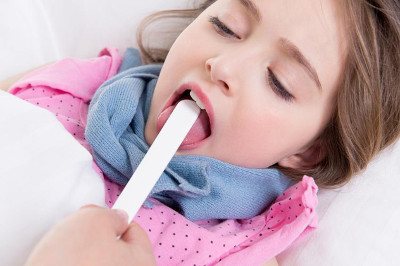You can often hear another name for sore throat - acute tonsillitis. An acute infectious disease primarily affecting the tonsils. Any microorganisms (bacteria, viruses, and even fungi) can provoke the occurrence of a sore throat. But the primacy among the causative agents of sore throat rightfully belongs to streptococci, which enter the human body after contact with the patient or his household items.
There is another scenario for the occurrence of a sore throat - when microorganisms that normally live quietly in a person’s throat, under the influence of unfavorable circumstances, are activated, causing a sore throat. Such circumstances include hypothermia (both general and local), decreased immunity, impaired nasal breathing (nasopharyngeal diseases), infections from bad teeth, etc.
The main thing that everyone must remember: sore throat is extremely contagious and both the patient himself and those around him must be very careful and follow safety rules, especially when it comes to children’s illness or complex forms of the disease.
Symptoms of a sore throat
The symptoms of tonsillitis are quite varied. So, there are quite typical symptoms that occur very often and directly indicate a sore throat. And there are atypical or individual ones that may be characteristic of other diseases. Let's look at the most common ones:
- elevated body temperature (over 38 degrees);
- painful sensations in the throat (especially when swallowing);
- formation of pustules on the tonsils (visible during the initial examination);
- inflammatory process in the area of the tonsils and pharynx (also visible to the naked eye);
- general weak condition (malaise is one of the main symptoms of sore throat, although not quite typical);
- aching joints (not always);
- enlarged lymph nodes (not always).
It is important to understand the main thing: the listed symptoms may occur all at the same time, or may not occur at all (at least in the patient’s opinion), and may resemble a common cold. So, the throat with a sore throat is red and painful, but not always. Hence the conclusion - a cold that lasts more than five days should prompt you to see a doctor.
Symptoms of herpetic sore throat
The disease begins acutely. From the moment of infection to the first symptoms, it takes from 2 to 14 days3. The temperature rises to 38-39°C. The patient feels weakness, headache, chills, less often nausea, possible vomiting and enlargement of the submandibular lymph nodes, 1,2,3.
Herpangina goes through several stages2:
- The day before the rash appears in the throat, the patient feels a mild pain. On examination, you may notice redness of the palatine arches and the back wall of the pharynx.
- Then, rashes appear on the mucous membrane of the soft palate, palatine arches, tonsils and uvula - small papules (nodules) up to 5 mm in diameter with a red rim.
- The nodules turn into vesicles, which open after 1-2 days.
- In their place, painful erosions with a gray-white coating form.
Up to contents
In children
Children get tonsillitis much more often than adults. And the reason for this is simple - children attend children's groups, where there are all the conditions for the spread of infection. Let's add here diseases of the ENT organs, which provoke tonsillitis, and are also constant companions of children (primarily due to age-related physiological characteristics). The most common viral tonsillitis in children, but bacterial tonsillitis, staphylococcal tonsillitis, and even herpetic tonsillitis may also occur.
We must also not forget that children’s immunity is much weaker in comparison with adults, the liver is not more perfect, and the effect of antibiotics is more undesirable for it. That is why all parents who want to preserve their children’s health should seek medical help at the slightest suspicion in order to minimize risks and consequences.
Speaking of sore throat, psychosomatics can also play an important role. Thus, psychologists suggest that the cause of sore throat in a child may well be the lack of opportunity to express his opinion, to talk about what he does not like. Parents, we recommend that you pay attention to this interesting fact.
Treatment of acute tonsillopharyngitis
Antibiotic therapy is recommended for any patient with symptomatic pharyngitis or tonsillopharyngitis who has a positive rapid antigen or culture test for group A streptococcus.
Empirical treatment is generally not recommended because there is significant overlap between the clinical features of GABHS pharyngitis and nonstreptococcal pharyngitis. Short delays in therapy (eg, while awaiting culture results) do not increase the incidence of complications, including acute rheumatic fever. However, it is unknown whether such treatment delays affect the incidence of other complications (eg, development of peritonsillar abscess).
If clinical suspicion for GABHS pharyngitis is high and test results cannot be obtained quickly, it is advisable to initiate antibiotic treatment while awaiting test results. If the diagnosis is not confirmed, antibiotics should be stopped.
Antibiotic treatment is not recommended for asymptomatic chronic GABHS carriers or for GABHS carriers with signs of acute viral pharyngitis.
Antibacterial therapy
The drug of choice for the treatment of GABHS pharyngitis is penicillin antibiotics. Penicillin is the only antibiotic that has been studied and shown to reduce the incidence of acute rheumatic fever. For complete eradication of GABHS, the duration of the course of antibacterial therapy is 10 days.
Amoxicillin is more preferable for young children. It can be given once daily using an extended-release form (suspension). In several randomized trials, amoxicillin suspension at a standard dose (once daily) was found to be as effective as penicillin taken orally.
In case of allergy to penicillins or poor tolerance, preference is given to cephalosporin antibiotics, lincosamides (clindamycin) and macrolides - the choice of drug depends on the type of allergic reaction to penicillin.
Studies that combined data from more than 5000 adults and children showed no clinically significant difference between cephalosporins, macrolides, or clindamycin compared with penicillin or amoxicillin in the resolution of GABHS tonsillitis symptoms. But no studies have assessed the use of alternatives to penicillin for the prevention of acute rheumatic fever. Thus, penicillin remains the drug of choice whenever possible.
Tetracyclines, sulfonamides and fluoroquinolones should not be used to treat streptococcal pharyngitis due to high resistance and high side effect profile.
Nonsteroidal anti-inflammatory drugs (ibuprofen) or acetaminophen (paracetamol) may be used to relieve fever and pain.
How is acute tonsillopharyngitis treated at the Rassvet clinic?
When diagnosing a sore throat, we always pay attention not only to the pharyngoscopy picture, but also to the presence of signs of a viral infection. This means we do not perform streptococcus tests on all patients with acute pharyngitis.
If there are signs of GABHS pharyngitis, we must perform a rapid test; if indicated, we take material for testing only for GABHS. Confirmation of streptococcal infection helps prevent unnecessary prescription of antibiotics for viral pharyngitis.
We do not prescribe throat swabs for flora. Streptococcal infection is one of the few causes of tonsillopharyngitis for which treatment with antibiotics is recommended. To this day, the need for antibacterial therapy for most other pathogens remains controversial. Other bacterial infections that strictly require treatment include diphtheria and gonorrhea.
We do not order an ASLO test on the first day of illness (ASLO - antistreptalizin-O, antibodies produced in response to the toxin of group A beta-hemolytic streptococcus). ASLO increases only 10-20 days after the onset of streptococcal infection. There is also no point in monitoring it every week, since this marker begins to decrease 3-5 weeks after the illness, but its levels can be higher than normal for up to a year.
We understand that the main goal of antibiotic therapy for streptococcal pharyngitis is to prevent complications. Treatment with antibiotics has been shown to reduce the severity of symptoms and speed recovery in patients with streptococcal pharyngitis, but even without antibiotic therapy, in most cases, symptoms resolve within three to five days.
We do not treat any plaque in the throat with antibiotics, since their presence does not equal streptococcal tonsillitis, nor vice versa.
In adults
Although an adult’s body is much stronger than a child’s, and the immune system is stronger, it is not even easy for him to endure a sore throat. Especially if there is a delay in contacting a specialist or inadequate treatment.
Sore throat during breastfeeding is also more than unpleasant, when the antibiotics necessary for treatment can pass through the mother’s milk to the baby and harm him. That is why pregnant and breastfeeding women should be even more careful, and if necessary, immediately consult a doctor, who is obliged to make the most appropriate decisions according to the situation.
Forms
Modern medical science identifies quite a few types of sore throat, which are the prerogative of specialists to understand. Within the framework of this discourse, we will consider several of its main forms: catarrhal, follicular, lacunar and necrotic.
Each type of sore throat differs from others in the degree and depth of damage to the tonsils themselves, as well as the localization of the inflammatory process.
For angina, the incubation period can range from 10 hours to several days. The very second name for sore throat “acute tonsillitis” indicates the acute onset of the disease (a sharp jump in body temperature, painful sensations in the throat, etc.)
How long does the temperature last for sore throat in children?
Parents are often concerned about the question: how long does a child’s temperature last with a sore throat? Can it go away if I start treatment with antibiotics right away? And is maintaining a high temperature a criterion for the ineffectiveness of an antibiotic?
In fact, the high body temperature will persist until the inflammation in the throat is eliminated. Treatment of sore throat with antibiotics in children does not have an immediate antipyretic effect; its goal is to destroy pathogens. At the same time, if the medicine was chosen correctly, then 10-12 hours after starting to take it (less often - after a day), the temperature will begin to decrease. This is due to the destruction of a large number of streptococci and a decrease in the activity of the inflammatory process in the tonsils.
If, on the third day after the start of treatment, the temperature persists (as well as other symptoms of the disease), then this is a reason for the doctor to choose another, more effective, antibiotic for a child with a sore throat.
But even with well-chosen treatment, the temperature of a child with a sore throat will decrease gradually. Complete normalization of body temperature most often coincides with the disappearance of other symptoms, that is, it occurs 5-7 days after the onset of the disease.
How to relieve throat swelling?
Swelling of the tonsils when they are damaged by streptococcus is a natural reaction to the inflammatory process. Therefore, for a disease such as purulent tonsillitis in a child, treatment aimed at destroying the pathogen will also lead to a reduction in swelling.
In what situations may swelling due to bacterial inflammation in the throat require additional measures? For example, when a child aged 3 years or younger has a sore throat: due to the structure of the pharynx, an increase in the size of the tonsils can lead to difficulty breathing.
How can you tell if your child is developing edema? He begins to breathe heavily, sometimes with a sore throat the child may snore, the skin turns pale, and the baby becomes restless. In this case, it may be necessary to hospitalize the child - measures will be taken in the hospital to reduce swelling and restore difficulty breathing.
Also, swelling, accompanied by difficulty breathing, develops with abscesses that complicate a child’s sore throat. How to treat such complications? Most often, emergency surgery is required.
Is it possible to walk with a child with a sore throat?
The purulent process in the tonsils is a serious burden on the child’s body, including the cardiovascular system, which suffers from the effects of toxic substances. In this regard, in the first days of the disease, the little patient is given complete rest and bed rest. So is it possible to walk with a sore throat? Doctors strongly recommend staying at home until the child’s condition returns to normal.
How to reduce sore throat with sore throat?

A sore throat that bothers the child and makes it difficult to swallow almost always accompanies inflammation of the tonsils associated with streptococcal infection. How to relieve a sore throat with a sore throat?
The manifestation of pain is a reaction to damage to the tonsils by the pathogen and the development of edema. But at the same time, there are factors that increase pain. For example, if a child breathes dry air, a film forms on the tonsils, increasing discomfort. Considering the treatment of a disease such as tonsillitis in children, Dr. Komarovsky advises, first of all, to provide cooling (up to 18-20 ° C) and humidification of the air in the room (50-70%) where the patient is lying.
A well-known pediatrician does not recommend using various sprays for sore throat for children, as well as lozenges and lozenges. The doctor believes that gargling with saline, soda solution, or even plain water, as well as drinking plenty of fluids, will also help relieve a sore throat.
Is there a vaccine against sore throat for children?
To date, there are no vaccines that would allow the body to develop resistance to streptococcal infection. In addition, a child who has had streptococcal tonsillitis runs the risk of getting sick again, since immunity to this pathogen is not formed.
However, as an effective method of prevention, it is advisable to consider the method of phonation of the body, which can be carried out at home.
Catarrhal sore throat
The lightest form. The catarrhal form is indicated by superficial lesions of the tonsils. The patient almost always does not feel very bad - the temperature does not rise above 38 degrees, tests show minor changes in the blood or no changes at all. Upon examination, the doctor discovers inflammation in the tonsils, pharynx, and palate. And after a couple of days, everything goes away and the patient recovers (perhaps without knowing that he had a sore throat), or the disease passes into another, more persistent form.
Causes
The main cause of sore throat is contact with the source of infection (that is, the patient). As already noted, the disease has a very high spread, so the risk of getting sick after contact is very high. Another possible reason is a malfunction in the body (other infections, hypothermia, etc.), as a result of which immunity is reduced and microorganisms present in the throat are activated. As a conclusion, you should avoid contact with people with tonsillitis, and increase the body’s defenses in every possible way.
Causes of sore throat, pathogens
Acute tonsillitis (tonsillitis) in 80-85% of cases occurs when the body encounters pyogenic streptococcus (group A β-hemolytic streptococcus), which requires contact with a person with a sore throat.

Transmission routes are possible: airborne droplets, contact (through a shared toothbrush, for example) or nutritional (with food). Children from 5 to 15 years old are especially sensitive to streptococcal infections and suffer from sore throat more often than other categories of patients.
The likelihood of the disease increases significantly when the body is weakened due to hypothermia, a previous respiratory viral infection, or hypovitaminosis.
Therefore, the incidence of sore throat is seasonal - in the cold, damp season, during epidemics of influenza and other respiratory viral infections.
Overcrowding (kindergartens, schools, businesses) also contributes to the spread of the disease.
In such a situation, the cause of inflammation of the tonsils can be microorganisms that a healthy body can cope with. Pneumococcus, staphylococcus, Haemophilus influenzae, fungi, spirochetes, viruses also cause sore throat. Even foci of chronic infection (caries, chronic sinusitis) can cause a sore throat.
Classification of tonsillitis (acute tonsillitis)
Primary tonsillitis is bacterial, caused by pathogenic or opportunistic microbes (primarily hemolytic streptococcus)
Secondary - against the background of other infectious diseases - diphtheria, scarlet fever, infectious mononucleosis, syphilis, tuberculosis. Sore throat due to blood diseases (leukemia, agranulocytosis) is also secondary.
By type of sore throat pathogen:
1. Bacterial
2. Viral
3. Fungal According to the nature of the local process, a sore throat may be:
1. Catarrhal - inflammation of the tonsils without plaque formation. The tonsils are enlarged in volume, hyperemic, fever and general symptoms are moderate;
2. Follicular - small white lesions appear on the surface of enlarged hyperemic tonsils - the purulent contents of the follicles are visible. Sometimes such tonsils are compared to a picture of the starry sky;
3. Lacunar - the purulent contents of the follicles come to the surface of the tonsil and look greenish, protruding above the surface, merging with each other. The plaque is easily removed, the surface of the tonsils does not bleed;
4. Ulcerative-membranous (necrotic) - plaque is dirty gray in color, merges into large foci, after removing the plaque the surface bleeds, pockets of ulceration remain. Symptoms of intoxication are pronounced.

Catarrhal tonsillitis can be an independent form or the initial stage of follicular and lacunar tonsillitis. The necrotic form also progresses through milder lesions of the tonsils.
Main signs/symptoms of the disease:
Sore throat with or without swallowing;
Difficulty swallowing due to pain and narrowing of the entrance to the pharynx;
Hoarseness, change in voice tone;
Bad breath (more pronounced with fungal sore throat, in the necrotic stage);
Increased temperature (low-grade in case of catarrhal, viral, fungal form, up to 39-400C with chills in case of any purulent or complicated sore throat). An increase in temperature during angina is, as a rule, permanent;
General symptoms are weakness, sweating, headache, muscle pain, chills, loss of appetite;
Neck pain, enlarged submandibular and cervical lymph nodes.
Complications of sore throat
Early complications develop in the first 6-9 days. Caused by the spread of infection to surrounding tissues and organs, sometimes with the formation of purulent foci.
These include: 1. peritonsillar abscess (an asymmetrical enlargement of one of the tonsils appears, severe fever, chills, pain when moving the neck and when swallowing);
2. retropharyngeal abscess (purulent lymphadenitis of the lymph nodes of the retropharyngeal space - difficulty swallowing, severe intoxication, fever);
3. sinusitis and otitis (inflammation of the paranasal sinuses, middle ear);
5. sepsis (spread of pathogens and toxins through the bloodstream throughout the body, a condition requiring intensive care in a hospital);
Such complications develop with inadequate treatment and in weakened patients (for example, with HIV infection). Patients require hospitalization, and sometimes the purulent lesions are opened and drained.
Late complications develop 2-3 weeks from the onset of the disease. Their pathogenesis involves an infectious-allergic autoimmune reaction. The body responds to microbial agents by producing protective antibodies. With high reactivity of the body, there are a lot of antigen-antibody complexes and they, lingering on the walls of blood vessels, kidney membranes, elements of connective tissue (including heart valves) damage these structures.
Manifestations of such a reaction may be:
rheumatic joint damage;
endomyocarditis (damage to the valve apparatus and heart muscle);
glomerulonephritis (serious kidney disease);
Late complications are more common when the protective regimen is not followed or drug therapy is inadequate. The main danger of streptococcal sore throat is due to these complications.
Diagnosis of sore throat
Patient complaints, connection with hypothermia or contact with a person with a sore throat;
Examination by a doctor (measurement of body temperature, general examination, pharyngoscopy (examination of the throat with a spatula and a flashlight), palpation of the lymph nodes of the neck, listening to the lungs, etc.);

Clinical blood test (an increase in the number of leukocytes, an inflammatory “shift” in the leukocyte formula, acceleration of ESR), urine (the appearance of protein during complications) can be detected;
Bacteriological examination of a smear from the oropharynx (including using a rapid test for hemolytic streptococcus) with inoculation of the microflora and determination of its sensitivity to antibiotics;
After 5-7 days, it is advisable to do an ECG;
In severe cases, determination of inflammatory markers (antistreptolysin-O, CRP, rheumatic factor).
Complications and consequences
In order not to frighten us once again with the possible consequences of a sore throat, let us immediately note: in most cases, when the patient consults a doctor on time and begins to receive adequate treatment on time, the sore throat goes away without complications. But you still have to know about possible risks. Thus, the consequences and complications can be both local (local) and general in nature.
Local:
- abscesses;
- swelling of the larynx;
- bleeding in the tonsils and others.
The general ones include:
- the occurrence of chronic tonsillitis;
- damage to internal organs: kidneys, liver, heart, gastrointestinal tract. So, often after a complex sore throat, appendicitis becomes inflamed;
- rheumatism;
- meningitis;
- infectious-toxic shock;
- the most serious is blood poisoning (sepsis), which can even lead to death.
And again, it is appropriate to recall that self-medication in case of a sore throat is unacceptable.
Treatment of sore throat
The main rules for the treatment of sore throat:
1. Self-medication in case of sore throat is unacceptable (at least in view of serious risks and complications). If some “home”, “folk” remedies and procedures are still acceptable, they should either be recommended by the attending physician or be agreed upon with him.
2. In the treatment of sore throat, the most important thing is to choose the right antibiotics.
3. The choice of antibiotic is the task exclusively of a specialist, that is, a doctor.
Hence the main conclusion - there should always be a doctor between you and a sore throat, and at the slightest suspicion, we turn to the doctor. Any methods of self-medication must be agreed with the attending physician, and are far secondary in comparison with antibiotic therapy.
For his part, the patient must:
- strictly follow the doctor's instructions;
- eat a varied and nutritious diet (drink more fluids);
- get more rest (in difficult cases, hospitalization is required);
- It is quite acceptable to use analgesics (at temperatures above 38 degrees, painful conditions). It is better if they are also prescribed by a doctor.
It is equally important that treatment can be stopped only with the permission of the attending physician, even if the patient feels completely recovered, in order to avoid relapses and complications.
The International Medical Center employs highly qualified specialists (both broad and narrow) who will provide you with qualified assistance and minimize the possible consequences of a sore throat. There is everything for recovery here - the best doctors, a high level of diagnostic equipment, the most modern medical facilities, comfortable conditions and European service. When you contact K+31 Clinic, you can always be sure that you are receiving the best treatment.
Treatment of herpetic sore throat
Patients with complications require hospitalization in an infectious diseases hospital and treatment under the supervision of specialized specialists - a neurologist and a cardiologist. If the doctor has recommended treatment at home, it is necessary to closely monitor the patient's condition2.
The sick person should be isolated and stay in a clean, well-ventilated area so as not to infect other family members. Quarantine must be observed until symptoms subside1.

For herpangina you should 1,3,4:
- Wash your hands as often as possible, including after feeding and changing a sick child’s diaper.
- Disinfect surfaces and objects with which the patient has been in contact.
- Drink enough fluids to avoid dehydration. At the same time, pay attention to the temperature of the drink: hot, warm drinks irritate the mucous membranes and cause additional discomfort. You can drink cool drinks.
- Consume food in liquid or mushy form. Spicy, salty, sour foods, including fresh fruits even in the form of puree, are not suitable for a patient with herpetic sore throat.
- Rinse your mouth with a saline solution after every meal to maintain oral hygiene and prevent bacterial infections from erosions.
- Use a soft toothbrush to reduce trauma to the mucous membrane.
Currently, there is no proven antiviral drug to treat herpangina by acting on its causative agent. Sometimes a doctor may prescribe medications that support local immunity of the pharyngeal mucosa1. Antibiotics are not prescribed for herpangina6.
The goal of treatment for herpangina is to relieve the symptoms of the disease4.
If the body temperature is above 38.5°C, physical methods such as cold compresses and ice packs may be used. Your doctor may also recommend anti-inflammatory and antipyretic medications1. Local treatment includes agents with anti-inflammatory, analgesic, enveloping and antiseptic effects1.
For the symptomatic treatment of herpetic sore throat, the doctor may prescribe the drugs HEXORAL®7,8,9,10,11. It is convenient to use HEXORAL® spray to irrigate the pharyngeal mucosa. The active substance of the spray is hexethidine. It acts against the main bacteria found in the oral cavity and pharyngeal mucosa8. The drug is also active against some viruses and fungi of the genus Candida8. Thanks to the local anesthetic effect of hexethidine, HEXORAL ® spray helps reduce pain8. HEXORAL®7 solution is suitable for rinsing. The use of HEXORAL ® spray and solution is allowed in children over 3 years of age7,8.
If herpangina causes severe pain and discomfort, adolescents over 12 years of age and adults can benefit from HEXORAL ® TABS EXTRA lozenges, which contain the anesthetic lidocaine10. For children over 4 years of age, HEXORAL ® TABS lozenges may be suitable. The anesthetic benzocaine in their composition helps reduce pain in the throat and mouth9.
All medications for herpetic sore throat should be used only after consultation with a doctor. In case of severe erosions, HEXORAL ® solution and spray are contraindicated7,8, and lozenges can only be prescribed by a specialist after examining the pharynx9,10.
Up to contents
The information in this article is for reference only and does not replace professional advice from a doctor. To make a diagnosis and prescribe treatment, consult a qualified specialist.
Prevention of sore throat
As already mentioned, the best preventive measures against this disease are:
- Minimizing contact with the source of infection (primarily, patients with tonsillitis). If contact cannot be avoided, all safety measures must be taken (during contact, wear a mask, after it, rinse the nasopharynx, etc.).
- Work on increasing immunity (both general and local).
- Try to take everything calmly. Sore throat, if you approach it wisely, is far from the most terrible disease in life, which can be successfully treated today. The main thing is to contact a competent specialist.
Prevention of acute tonsillopharyngitis
Hand hygiene is a key measure to prevent the spread of infection. Hands should always be washed after episodes of coughing or sneezing, and before preparing or preparing food.
Vaccination—A vaccine against GABHS is not yet available. However, research into its development continues.
Author:

Chekaldina Elena Vladimirovna otorhinolaryngologist, Ph.D.









